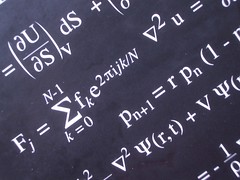 |
The question J. Grabowski, M. Rotkiewicz and I asked was ‘how can we superise a (purely even) graded manifold?’ We propose an interesting solution in our latest preprint Superisation of graded manifolds. |
We start with the problem of passing from a particular ‘species’ of graded manifold, known as graded bundles [1]. Graded bundles are non-negatively graded (purely even) manifolds for which the grading is associated with a smooth action of the multiplicative monoid of reals. Such graded manifolds have a well defined structure, nice topological properties and a well defined differential calculus. For these reason we decided that this special class of graded manifold should be the starting place.
Moreover, any vector bundle structure can be encoded in a regular action of the monoid of multiplicative reals. A graded bundle is a ‘vector bundle’ for which we relax the condition of being regular. As everyone knows, the parity reversion functor takes a vector bundle (the total space of) and produces a linearly fibred supermanifold. This functor just declares the fibre coordinates of the vector bundle (in the category of smooth manifolds) to be Grassmann odd. Importantly, one can ‘undo’ this superisation by once again shifting the Grassmann parity of the fibre coordinates. Thus, the parity reversion functor acting on purely even vector bundles is an inconvertible functor and we establish a categorical equivalence between vector bundles and linearly fibred supermanifolds.
Passing to graded bundles
However, such a direct functor cannot exist for graded bundles. Graded bundles are not ‘linear objects’, the changes of non-zero weight local coordinates are polynomial. Simply declaring some coordinates to be Grassmann odd is not going to produce an invertible functor: we have nilpotent elements and now terms that are skew-symmetric which by contraction with symmetric terms in the transformation laws will vanish. In short, some information about the changes of local coordinates is going to be lost when we superise by brute force. We do obtain a functor that takes a graded bundle and produces a supermanifold, but we cannot go back!
Any meaningful ‘superisation’ of a graded bundle must be in terms of an invertible functor and allow us to establish a categorical equivalence between the category of graded bundles and some subcategory of the category of supermanifolds (or some other ‘super-objects’).
Our solution to this conundrum is a two stage plan of attack: first fully linearise and then superise.
Full linearisation
First we fully linearise a graded bundle by repeated application of the linearisation functor [2]. In this way we get a functor that takes a graded bundle of degree k and produces a k-fold vector bundle. In the paper we characterise this functor and make several interesting observations, especially in relation to the degree two case.
The basic idea of the full linearisation is that we polarise the polynomial changes of local coordinates. That is, we add more and more local coordinates in such a way as to fully linearise the changes of coordinates. We do this by repeated application of the tangent functor and substructures thereof. We also have an inverse procedure of diagonalisation, which allows us to ‘undo’ the full linearsation.
As a k-fold vector bundle is ‘multi-linear’ we can superise it!
Standard superisation
Following Voronov [3], we can apply the standard parity reversion functor to a k-fold vector bundle in each ‘direction’ and obtain a supermanifold. Thus, by fully linearising a graded bundle and then application of the parity reversion functor in each ‘direction’ we obtain a supermanifold.
However, this procedure is not really unique: one obtains different functors depending on which order each parity reversion functor is applied. These different functor are of course related by a natural transformation, so there is no deep problem here. However, when we consider just vector bundles the parity reversion functor works perfectly and we have no ambiguities in our choice of functor. This suggest that we can do something better for k-fold vector bundles and our superisation of graded bundles.
Higher supermanifolds
Instead of using standard supermanifolds we can employ \(\mathbb{Z}_{2}^{k}\)-supermanifolds [4]. It is known from [4] that these ‘higher supermanifolds’ offer a neat way to superise k-fold vector bundles without any ambiguities. Thus, in our paper we apply this higher superisation to the lineariastion of a graded bundle.
In short, we can in a functorial and invertible way associate a \(\mathbb{Z}_{2}^{k}\)-supermanifold with a graded bundle answering our opening question.
References
[1] J. Grabowski & M. Rotkiewicz, Graded bundles and homogeneity structures, J. Geom. Phys. 62 (2012), no. 1, 21–36.
[2] A.J. Bruce, K. Grabowska & J. Grabowski, Linear duals of graded bundles and higher analogues of (Lie) algebroids, arXiv:1409.0439 [math-ph], (2014).
[3] Th.Th. Voronov, Q-manifolds and Mackenzie theory, Comm. Math. Phys. 315 (2012), no. 2, 279-310.
[4] T. Covolo, J. Grabowski & N. Poncin, \(\mathbb{Z}_{2}^{n}\)-Supergeometry I: Manifolds and Morphisms, arXiv:1408.2755[math.DG], (2014).